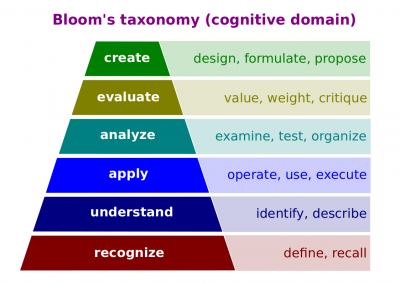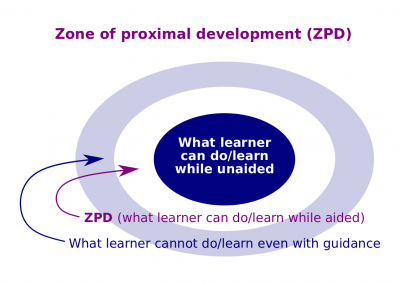Difference between revisions of "Educational Objectives"
(→Content) |
(→Script) |
||
| Line 15: | Line 15: | ||
:[[Educational objective]]s specify [[knowledge, skills, and abilities]] that a learner should gain as a result of a specified [[learning activity]] or a set of ''activities''. | :[[Educational objective]]s specify [[knowledge, skills, and abilities]] that a learner should gain as a result of a specified [[learning activity]] or a set of ''activities''. | ||
| − | + | To facilitate [[purposeful learning]], the [[Bloom's taxonomy]] attempts to classify [[educational objective]]s. | |
| − | :This '' | + | [[educator]]s distinguish three [[development domain]]s. |
| + | |||
| + | :The [[affective domain]] is concerned with [[emotion]]s and learners' well-being. | ||
| + | |||
| + | :The [[psychomotor domain]] is responsible for development of practical skills and [[action]]s. | ||
| + | |||
| + | :The [[cognitive domain]] targets development of one's understanding. Usually, the biggest part of [[curriculum|curricula]] addresses this ''domain''. | ||
| + | |||
| + | :This ''taxonomy'' identifies three domains and the [[cognitive domain]] reflects those ''objectives'' that account for [[knowledge]]. This domain lists 6 levels; they are knowledge, comprehension, application, analysis, synthesis, and evaluation. | ||
| + | |||
| + | :To illustrate these levels, let's use an example. When you learn this ''taxonomy'', you would first start recognize, define, and recall it. After some time, you would start to understand, identify, and describe it. Next, you would be able to apply, operate, use, and execute this ''taxonomy''. Later, you shall learn how to analyze, examine, test, and organize that. At the next level, you shall be able to evaluate, value, weight, and critique it. Finally, you may create, design, formulate, and propose its modifications. | ||
| + | |||
| + | :Many [[educational institution]]s use the ''taxonomy'' to build [[learning sequence]]s. | ||
'''[[What Training Is]]''' is the successor [[lectio]]. | '''[[What Training Is]]''' is the successor [[lectio]]. | ||
==Quiz== | ==Quiz== | ||
Revision as of 22:39, 11 May 2020
Educational Objectives (hereinafter, the Lectio) is the second lesson part of the Education Essentials lesson that introduces its participants to education and related topics.
This lesson belongs to the Introduction to Education session of the CNM Cyber Orientation. The Orientation is the second stage of the WorldOpp Pipeline.
Contents
Content
The predecessor lectio is What Education Is.
Key terms
- Educational objective. A goal of gaining specified knowledge, skills, and abilities by a learner as a result of a specified learning activity or a set of activities.
- Bloom's taxonomy. One of attempts to classify educational objectives.
- Zone of proximal development (ZPD). An educational construct that indicates the area that a learner can learn only if he or she is helped by a more competent other. ZPD lies in between the area that the learner can learn on his or her own and the area that the learner cannot learn even with the more competent other's assistance.
Script
- Educational objectives specify knowledge, skills, and abilities that a learner should gain as a result of a specified learning activity or a set of activities.
To facilitate purposeful learning, the Bloom's taxonomy attempts to classify educational objectives.
educators distinguish three development domains.
- The affective domain is concerned with emotions and learners' well-being.
- The psychomotor domain is responsible for development of practical skills and actions.
- The cognitive domain targets development of one's understanding. Usually, the biggest part of curricula addresses this domain.
- This taxonomy identifies three domains and the cognitive domain reflects those objectives that account for knowledge. This domain lists 6 levels; they are knowledge, comprehension, application, analysis, synthesis, and evaluation.
- To illustrate these levels, let's use an example. When you learn this taxonomy, you would first start recognize, define, and recall it. After some time, you would start to understand, identify, and describe it. Next, you would be able to apply, operate, use, and execute this taxonomy. Later, you shall learn how to analyze, examine, test, and organize that. At the next level, you shall be able to evaluate, value, weight, and critique it. Finally, you may create, design, formulate, and propose its modifications.
- Many educational institutions use the taxonomy to build learning sequences.
What Training Is is the successor lectio.


